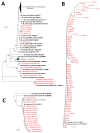Moraxella nonliquefaciens and M. osloensis Are Important Moraxella Species That Cause Ocular Infections
- PMID: 31167433
- PMCID: PMC6616425
- DOI: 10.3390/microorganisms7060163
Moraxella nonliquefaciens and M. osloensis Are Important Moraxella Species That Cause Ocular Infections
Abstract
Moraxella is an ocular bacterial pathogen isolated in cases of keratitis, conjunctivitis, and endophthalmitis. Gram-negative brick-shaped diplobacilli from ocular specimens, and slow growth in culture, are early indications of Moraxella ocular infection; however, identifying Moraxella to species can be complex and inconsistent. In this study, bacteria consistent with Moraxella were identified to species using: (1) DNA sequencing coupled with vancomycin susceptibility, (2) MALDI-TOF mass spectrometry, and (3) the Biolog ID system. Study samples consisted of nine ATCC Moraxella controls, 82 isolates from keratitis, 21 isolates from conjunctivitis, and 4 isolates from endophthalmitis. The ATCC controls were correctly identified. For keratitis, 66 (80.5%) were identified as M. nonliquefaciens, 7 (9.0%) as M. lacunata, 5 (6%) as M. osloensis, 2 (2.5%) as Acinetobacter lwoffii, 1 (1.0%) as M. bovis/nonliquefaciens, and 1 (1.0%) as M. osloensis/nonliquefaciens. For conjunctivitis, 9 (43.0%) were identified as M. osloensis, 6 (29.0%) as M. nonliquefaciens, 3 (14.3%) as Roseomonas, 2 (9.5%) as Acinetobacter (parvus, junii), and 1 (4.5%) as M. catarrhalis/nonliquefaciens. From endophthalmitis, 3 of 4 of the isolates were M. nonliquefaciens. Overall, M. nonliquefaciens and M. osloensis were identified in 70% (75 of 107) and 13% (14 of 107) of cases, respectively, totaling 83% (89 of 107). M. nonliquefaciens and M. osloensis are important bacterial pathogens of the eye as determined by DNA sequencing, MALDI-TOF MS, and Biolog. Although Moraxella catarrhalis is a clinical pathogen, other species of Moraxella appear to have a prominent role in eye infections.
Keywords: Biolog; DNA sequencing; MALDI-TOF MS; Moraxella; conjunctivitis; endophthalmitis; eye infections; keratitis.
Conflict of interest statement
The authors declare no conflict of interest.
Figures



Similar articles
-
Moraxella species: infectious microbes identified by use of time-of-flight mass spectrometry.Jpn J Ophthalmol. 2019 Jul;63(4):328-336. doi: 10.1007/s10384-019-00669-4. Epub 2019 Jul 4. Jpn J Ophthalmol. 2019. PMID: 31273564
-
Late-Onset Bleb-Related Endophthalmitis Caused by Moraxella nonliquefaciens: A Case Report.Antibiotics (Basel). 2023 Mar 18;12(3):607. doi: 10.3390/antibiotics12030607. Antibiotics (Basel). 2023. PMID: 36978474 Free PMC article.
-
Moraxella nonliquefaciens superinfecting herpes simplex keratitis.Eur J Ophthalmol. 2022 Nov;32(6):NP24-NP27. doi: 10.1177/11206721211019565. Epub 2021 May 20. Eur J Ophthalmol. 2022. PMID: 34015953
-
Infective endocarditis due to Moraxella lacunata: report of 4 patients and review of published cases of Moraxella endocarditis.Scand J Infect Dis. 2004;36(11-12):878-81. doi: 10.1080/00365540410024925. Scand J Infect Dis. 2004. PMID: 15764178 Review.
-
Bacteremia due to Moraxella osloensis: a case report and literature review.Braz J Infect Dis. 2018 Jan-Feb;22(1):60-62. doi: 10.1016/j.bjid.2017.10.008. Epub 2018 Feb 2. Braz J Infect Dis. 2018. PMID: 29409692 Free PMC article. Review.
Cited by
-
Endophytic Bacteria Potentially Promote Plant Growth by Synthesizing Different Metabolites and their Phenotypic/Physiological Profiles in the Biolog GEN III MicroPlateTM Test.Int J Mol Sci. 2019 Oct 24;20(21):5283. doi: 10.3390/ijms20215283. Int J Mol Sci. 2019. PMID: 31652989 Free PMC article.
-
Moraxella nasibovis sp. nov., Isolated from a Cow with Respiratory Disease.Curr Microbiol. 2023 Jul 26;80(9):305. doi: 10.1007/s00284-023-03415-9. Curr Microbiol. 2023. PMID: 37493823
-
Biological Control of Pest Non-Marine Molluscs: A Pacific Perspective on Risks to Non-Target Organisms.Insects. 2021 Jun 28;12(7):583. doi: 10.3390/insects12070583. Insects. 2021. PMID: 34203229 Free PMC article.
-
Atypical Microbiological Feature of Infectious Endophthalmitis on Jeju Island: A 10-Year Study at a Single Tertiary Referral Center.J Ophthalmol. 2021 Mar 2;2021:6620926. doi: 10.1155/2021/6620926. eCollection 2021. J Ophthalmol. 2021. PMID: 33747553 Free PMC article.
-
Speciation and Antibiotic Susceptibilities of Coagulase Negative Staphylococci Isolated from Ocular Infections.Antibiotics (Basel). 2021 Jun 16;10(6):721. doi: 10.3390/antibiotics10060721. Antibiotics (Basel). 2021. PMID: 34208455 Free PMC article.
References
-
- Morax V. Note sur un diplobacille pathogéne pour la conjunctivite humaine. Ann. Inst. Pasteur. 1896;10:337–345.
Grants and funding
LinkOut - more resources
Full Text Sources

